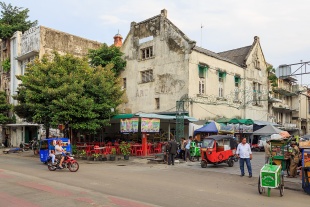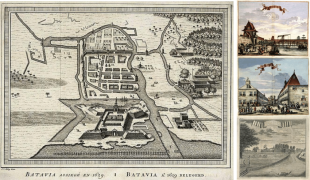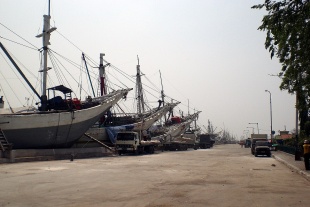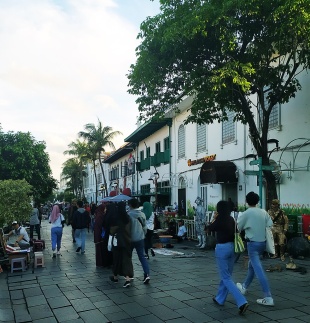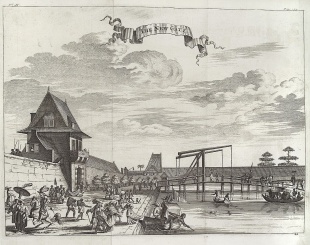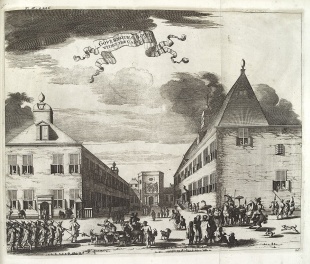KOTA
Kota (Old Jakarta, Old Batavia) is home to a number of colonial buildings but unfortunately many of them are in poor condition. Founded in the 17th century, it was the heart of the Dutch colonial operation in Indonesia. Also known as Batavia, is not the most pleasant of places, there are not many old buildings and those that remain have peeling paint and are sandwiched between shabby building.
Many of the remaining old temples, churches, and warehouses have been abandoned. An effort of sorts is being made to restore some of the old colonial building and make the area into a charming, atmospheric tourist-foreignly place. Some of the old docks have been fixed up and a -traditional watchtower now houses a museum.
Among the sites worth a look in Kota are Toko Merha, the former governors home, now occupied by the Dharma Niaga Company; the Chieck Market Bridge, the last remaining Dutch drawbridge in Indonesia; the Jakarta History Museum (See Below); the Wayang Museum (See Below); Bahari Museum (See Below); the Fine Arts Museum (See Below); Cannon Si Jagur, a huge bronze cannon with a huge fist ta the end, regarded as a fertility symbol and visiting by women who want children;
Adhityani Arga and Sugita Katyal of Reuters wrote: “It was once known as the "Queen of the East" because of its architectural splendor. But, today, the Indonesian capital's old Dutch quarters and once magnificent buildings are crumbling and dilapidated, with little trace of their time of glory when Jakarta was an international trading centre. "They're dying in front of your eyes. Some of these buildings have been rented out for gambling and prostitution," said Budi Lim, a conservation architect who has been involved in efforts to revive Old Town, or Kota Tua, for more than two decades. "Now is the time for the revival and renaissance of Kota." [Source: Adhityani Arga and Sugita Katyal, Reuters, July 3, 2007]
“During the late 19th and early 20th centuries, Jakarta, or Batavia as it was then known, was renowned for its picturesque Dutch colonial houses and tropical tree-lined streets. The city was dotted with grand mansions and country houses with wide verandahs, ideal for the warm climate, while palaces in the Greco-Roman classical style were also common features. Grand colonial-style government offices and Art Deco buildings stood side-by-side in the Old Town, while other treasures included a 16th century Chinese temple, old mosques and Moorish houses built by the descendants of Arab traders.
“Today, the polluted and congested metropolis isn't exactly a top draw on the tourist map. Jakarta's skyline is marked by gleaming glass-and-chrome skyscrapers towering over run-down buildings and slums, while the Old Town is a warren of abandoned warehouses, or gudangs, and rows of neglected shop houses near open sewers.
Transportation such as TransJakarta buses, bike-cabs, taxis, or rental cars or cars hired with a driver are available. In Jakarta, a cab is easy to find. Or take the Corridor I, Blok M - Kota TransJakarta Bus and stop at Kota, the final destination. Taking a cab from there will much cheaper than taking one from your hotel.
Various restaurants and fast food joints such as A&W and Dunkin' Donuts are available. Alternatively, you can buy fresh seafood from the Fish Market and ask the cooks in restaurants in Muara Angke area to cook them for you. Sights and activities include climbing Harbor-Master Tower to view Jakarta from the top; watching the ships loading and unloading the cargo in the harbor; Joining wayang workshops in the museum.
History of Kota
In its heydays in the 16th century, Batavia was known as “The Queen of the East” and “the Jewel of Asia”. Its Sunda Kelapa harbour was abuzz with merchant vessels from Europe, China, India and from throughout the Indonesian archipelago, loading in and sailing away with precious nutmegs, pepper, tea, coffee, ceramics, cloths and other exotic products of the time. The warehouses were stacked with spices, tin and copper. The successful trade in Batavia filled the coffers of the Netherlands’ Treasury. .
The center of the VOC Dutch East India Company’s administration was the Stadthuis with its wide front plaza, around which were the Court of Justice, banks and other important buildings. Later the city expanded to the west bank of the Ciliwung river, where the Dutch built a fortress, a city wall and canals, outside which was Chinatown and the homes of the indigenous people.This entire area, covering 1.3 square kilometers is today called the Old Batavia, present day part of North and West Jakarta.
Before this, in 1526, Prince Fatahillah of Banten invaded the harbour of Sunda Kelapa of the West Javanese kingdom of Pajajaran, On 22 June 1527 he renamed the town Jayakarta meaning victorious city. Until today, Jakarta bases its founding on this date. In 1619, however, Dutch Governor Jan Pieterszoon Coen destroyed the town, upon which he built the new town of Batavia — naming it to the ancestors of the Dutch, the Batavieren.
According to a report submitted to UNESCO:“As the centre of a network of European and Asian, Intra-Asian and inter islands trade in Indonesia, Batavia developed unique cross cultural traditions such as: Maardijker culture, Indies culture (Eurasian) and Chinese Peranakan culture. This tangible and intangible heritage is visible in the various different religious buildings, in European, Chinese and local Indonesian architectural styles and techniques, in Indian, Dutch and Chinese influences on furniture and on cuisine — mixing with local styles and tastes. It is also seen in music such as Tanjidor (European) and Keroncong (Portuguese fado). [Source: Permanent Delegation of the Republic of Indonesia to UNESCO]
“The 17th and 18th century also saw an intermingling of many local peoples from all over the Indonesian Archipelago, bringing with them their own differing cultures, beliefs and traditions who settled in Batavia as reflected in the many quarters still bearing local ethnic names. This intermingling on an unprecedented scale in Indonesian history provided the living example for the creation of an Indonesian state out of the many islands, languages and beliefs and more importantly the creation of an Indonesian culture which not only reflects the many traditions of the Archipelago but also all the major cultural traditions in the world namely: Western culture, Chinese culture, Indian culture and Middle Eastern culture. Such a culture has a very important role to play in the civilizations.”
UNESCO Description of the Old Town of Jakarta (Formerly Old Batavia)
The Old Town of Jakarta (Formerly old Batavia) and 4 Outlying Islands (Onrust, Kelor, Cipir dan Bidadari) was nominated to become a UNESCO World Heritage Site in January 2015: According to a report submitted to UNESCO: Located at the mouth of the Ciliwung River in Java, the Old Town of Jakarta was established by the VOC in 1619. Its 17th century town plan was completed in 1650. In 17th and 18th century VOC had largest volume of trade in the world, governed from Batavia. No colonial town built by VOC matched the grandeur and completeness (military, civil engineering, and urban elements) of Dutch town planning & architecture of Batavia. According to a report submitted to UNESCO:
“The nominated property is considered to be of Outstanding Universal Value as a cultural property for the following reasons. 1) As an excellent example of Dutch colonial city town planning and architecture during the 17th-18th century which were the golden age of the VOC. 2) As the most complete surviving Dutch Colonial Capital City located at the centre of the web of the vast Dutch trading network in 17th-18th Century. The spice trade route from the Netherlands to the Middle East, the Indian Subcontinent, China, Japan, South Africa and the Spice Islands produced in Batavia, a city with multicultural heritages alive till today and which influenced the creation of an Indonesian culture reflecting all of these. 3) As a living testimony to the multi cultural heritage and traditions of Asia. Where European, Chinese, Arabian, and Indian cultures met with local cultures and created unique mixture of Peranakan cultures. 4) As an example of sea use which reflects a unique maritime culture preserved until now in the traditional boat wharf of Jakarta Old Town where venacular boats come from all over Indonesia until now bringing trade commodities. The wharf is one of the most important harbours for traditional craft which would suffer a big setback without it.
“This criterion is justified on the grounds that the Old Town of Jakarta represents the most exceptional example of “Dutch Colonial City” town planning during the 17th and 18th century period of the VOC when Batavia was the town with the largest volume of trade in Asia. It is most likely that the town planners of Batavia were influenced by the ideals of Simon Stevins “ideal city” of the 17th century as were many of the other VOC colonial towns of the period. Based on (1) Spatial/functional. (2) Institutional and (3) Centrally located- Batavia stand out among other Dutch Colonial Cities and Settlements. The town is divided into a selection of grids created by the canals built to make transportation easier and the buildings were built in the blocks created by these grids. Batavia was established by the Governor General of the VOC, thereby providing an institutional framework for the town. The city also contained large built structures from each of the following three categories: military (forts, redoubts, city walls), civil engineering (canals, sluices, dikes, bridges) and urban street design (including a public space that takes the common good into account).
This criterion is justified on the grounds of the unprecedented amount of trade that the VOC created and which ushered in a significant stage in human history namely the Golden Age of Trade of the VOC which was reflected in Batavia as the headquarters of the VOC in Asia in: The multi-layer grid of canals built by the Dutch created not only to dry the swamplands around Batavia but also to provide transport for commodities coming from the hinterlands behind Batavia and arriving and leaving by ship which made trade far more efficient and made supplying the inhabitants of Batavia far easier.”
Buildings and Sights in Kota (Old Batavia)
Kota is often referred to Old Batavia. The 1650 town measured 1.5 kilometers km by one kilometer with 4 major areas on the Ciliwung River sides. West side: former Jayakarta and two 18th century houses. North west side: West Warehouse, old town wall remains, Floating Warehouse, VOC shipyard, Luar Batang Mosque. East side: East Warehouse, Town Square, Town Hall. South east side: China Town. Kalibesar Canal with traditional boats wharf. Islands: Onrust, Kelor, Cipir & Bidadari with shipyard and forts. [Source: UNESCO]
Behind the President’s Palace is the canal which runs north pass the old Archive building to the Old Batavia, once the seat of the Dutch East Indies Company, VOC, built by Governor-General Jan Peterszoon Coen in the 17th century. Here renovations continue to preserve this historic area of the city which is dominated by the Stadhuis, or municipal building, which now houses the Jakarta History museum. In front of it is a central paved plaza, now named the Fatahillah Square, after Sultan Fatahillah, founder of this port, who, before the arrival of the Dutch razed the old harbour to the ground on 22 June 1527 and renamed it Jayakarta, City of Victory. The square is surrounded by once important Dutch government buildings that have now become museums, among which the Fine Arts Museum, the Wayang Museum, and the Museum Bank Mandiri.
Today, the former location of Batavia town proper is Jakarta’s predominantly Chinese business district, but a large part of this is now modernized with full air-conditioned shopping centers and hotels. Many of the original buildings are dilapidated but still intact, The government has designated the Old Batavia as conservation area and plans are afoot to revive the entire neighbourhood into a tourst destination.
Center of the Old Batavia is the former municipal building or Stadthuis, which is now a Museum depicting Jakarta’s long history, called Museum Fatahillah, while the square is called the Fatahillah Square. The Fatahillah Museum is built in classical baroque architecture consisting of a main building with two wings on its east and west, acomplementary building used as an office, a court room, and an underground prison. These frightening prison cells contain heavy iron balls used to shackle prisoners and slaves.
Around the square are the Fine Art and Ceramic Museum, one time Court of Justice, which houses splendid paintings of the romantic maestro Raden Saleh, and expressionist Affandi. There is also a collection of ceramics from many parts of Asia. There is also the Wayang Museum, the Bank Indonesia and Bank Mandiri Museums, housing artefacts related to the banking world.
In the vicinity are the Sion Protestant Church, built in 1695 and still in use until today, the Pasar Ikan — or Fish market, the Kota Intan Drawbridge — a reminder of canals and bridges in Holland, and the old Jakarta Kota Station, also still operational today. The Café Batavia has been restored and now offers authentic Dutch cuisine, pastries, coffee and tea, in relaxing retro atmosphere with high ceilings, large windows, ceiling fans and wooden beams.
In Old Batavia, the Fatahillah museum is still a favorite site for culture lovers, photographers, local tourists and international tourists (particularly Dutch and other Europeans) and is open from Tuesday through Sunday, from 09:00-16:00 West Indonesia Time). The museum is closed every Monday and public holidays. Old Batavia is easiest reached via the toll road to Tanjung Priok harbour or the old road via Gunung Sahari past Mangga Dua, but this road is usually congested. Take a taxi or car. Once at the Fatahillah Square there are old-fashioned bikes for rent to cycle around and see the many attractions in this area.
Sunda Kelapa and Gereja Sion
Sunda Kelpa (near Kota) is the old port area. The port isn’t so interesting but some of the boats, including many sailing ships, such as Makaresse and Bugi schooners, are. There is a maritime museum (Bahari Museum) in a Dutch India Company warehouse. The exhibits include photographs of old boats and examples of crafts from around Indonesia and an interesting collection of ship models and maritime items. There s also a three story lookout tower here. It was built in 1839 and is all that remains of a Dutch fort that once stood here. Nearby is a fish market.
Here, aside from Sunda Kelapa Harbor, you can found Harbor-Master Tower (Menara Syahbandar), Maritime Museum (Museum Bahari), Fatahillah Museum, Wayang Puppet Museum, Arts Museum and Beos Station.
Gereja Sion (near the Kota train station) is the oldest remaining church in Jakarta. Built in 1695 and also known as the Portuguese Church, it was built by the Portugese near an area where Malays, Indians and other Asians were brought and given the the choice of becoming Cathoic or being slaves. When the Dutch took over they made similar demands about joining the Dutch Reformed Church. The layout of the church is simple and plain. On the interior are copper chandeliers.
Warehouses and Wharfs Along the Old Harbor of Old Batavia
The old harbor called Sunda Kelapa, in its heyday it was the thriving entrepot for the Far East trade in cloves, nutmeg and pepper, sandalwood, silks and more. Here one can still admire majestic Bugis phinisi schooners at anchor where men still carry on their backs loads of merchandise for the archipelago. A new Batavia Marina has been built near this harbor. Nearby are also the old warehouses where now stands the Maritime Museum. Today, the Sunda Kelapa Harbour is an inter-island harbour, where one can mostly find Bugis phinisi schooners at anchor. Nearly are the old warehouses, which are now converted into a Maritime Museum. This museum houses models of old Dutch ships and the many types of boats used in the archipelago.
According to a report submitted to UNESCO: “The VOC architecture and technology of building warehouses was the best of its time and also made trade more efficient. This was used in other VOC towns around the world and influenced those parts of the world in building warehouses. The town planners of Batavia were very likely inspired by the spirit of Simon Stevin’s ideal city which was in vogue in Holland. A grid pattern of canals was created with blocks in which buildings were built with the required elements of government, military and urban landscape: houses and buildings of various faiths. All created due to trade. d. Batavia and Onrust also recorded the technological ensemble which is very unique to that period (e.g.Windmill and watermill from Dutch). According to a report submitted to UNESCO:
“At the mouth of the river of the Old Town of Jakarta, there exists a wharf specifically for traditional/vernacular sailing boats from various parts of the Archipelago. Indonesia has the largest fleet of merchant sailing boats in the world and the boats of the various islands show different characteristics. This port for vernacular sailing boats is evidence of a unique maritime culture still in existence till today. It is an inter-island port. In the past Batavia was the most important port in Asia for inter-island, Inter-Asia and the Asia-Europe trading route. Today it is still one of the most important ports for inter-island traditional vernacular boats. These boats are an outstanding example of traditional sea-use which is representative of a culture or human interaction with the environment which has become vulnerable under the impact of the development of modern shipping technology”
Efforts to Preserve Kota
Adhityani Arga and Sugita Katyal of Reuters wrote: ““One reason why the city's architectural heritage hasn't been preserved, like Paris or Rome, is because Indonesia wanted to erase all memories of its colonial past which ended in 1949 after 350 years of Dutch colonial rule, conservationists say. "At first, many nationalists were against the idea of conserving Dutch buildings," said Ella Ubaidi, who co-founded Jakarta Old Town Kotaku (JOK), a seven-member committee that actively pushes the government to revive the area. "They thought it was unpatriotic because it glorified the Dutch colonial past. But if more people come to the Old Town, more shops will open, and people can come to admire old buildings and shop, just like in Paris and Rome." [Source: Adhityani Arga and Sugita Katyal, Reuters, July 3, 2007]
“But Jakarta may finally be a bit closer to getting the facelift conservationists have been dreaming about. As the city marks its 480th anniversary, conservationists have signed a preliminary pact with the government to revive the Old Town area. The team, which includes central bank deputy governor Miranda Goeltom and Lim, has drawn up a blueprint that aims to combine renovation and conservation with economic development and the promotion of art and culture in the old buildings. Lim envisions converting the abandoned historic buildings into art galleries and workshops for craftsmen. But the Kota Tua revival project is dependent on funds from the private sector, which may not be easy because most of the buildings are now owned by the government.
“Jakarta has a patchy conservation record. Only a small number of the city's 100 protected buildings have been preserved — among them the 18th century Presidential Palace, along with the stunning National Archives building and neo-Renaissance arts theatre in the heart of Jakarta.Even if the old town is renovated, it may fail to draw tourists to a city notorious for its pollution and traffic jams. "The Old Town area is polluted and dirty. Streets are full of junk, beggars and homeless people," said Ubaidi, who has been at the forefront of efforts to revive the old city. "Many thugs lurk in this part of the city. They command each and every inch of the Old Town area — they charge for parking, they ask for security fees from businesses and they also open the empty heritage buildings for homeless and charge them for space."
According to a report submitted to UNESCO: “The biggest threat the Old Town of Jakarta faces is the development of the city. The development of the Railway on the north side of the Old Town, the Freeway Port, and also Tanjung Priok Harbour slowly kill economic activities in the Old Town. This together with the building of bridges preventing use of the river for transportation. Before the development of freeway, railway station, and Tanjung Priok Harbour, the big ships dock far north in deep water. Smaller traditional boats would bring goods to the city via canal. Now the big ships dock in new harbour and goods are sent to Old Jakarta by train. This new route is faster, cheaper, and safer. The canal and river are allowed to silt up and become shallow. [Source: Permanent Delegation of the Republic of Indonesia to UNESCO]
“The development of the toll road and railway station from west to east cuts the city in two. The northern area is near the harbor while the south has become the city centre. The toll road and railway do not allow the urban beat from the south area to reach the north making it into a dead area. To protect the Old Town of Jakarta the City of Jakarta has issued Regulation no.36 of 2014 re heritage building and heritage areas. Parliament has issued Law number 11 of 2010 re Cultural Heritage Protection. To promote a sustainable tourism and increase the protection of Old Town Jakarta as tourism site — Minister of Tourism of Republic Indonesia has designated Old Town Jakarta as Prime Tourism Designation under ministerial decree no : KM.02.PW.202/MP/2014.” [Source: UNESCO]
Toko Merah: Jakarta’s Oldest Trade Building
Toko Merah or the Red Shop is one of the oldest buildings and best preserved in present day Old Batavia. Recently restored by its present owners the PT Perusahaan Perdagangan Indonesia (PT.PPI) - a conglomeration of state-owned enterprises for Trade, - the Red House has been reopened for meetings, conventions and art exhibitions. Located at Jalan Kali Besar Barat 107, along the once busy Ciliwung river, in the subdistrict of Roa Malaka, West Jakarta, Toko Merah was originally the home of Willem Baron van Imhoff, who later became Governor General of the East India Company from 1743-1750.
In its long history, the building was converted into a maritime academy from 1743-1755, the first and most prestigious maritime academy in the Far East at the time, then it became a Guest House for high ranking officials (Heerenlogement) from 1787 — 1808. One famous guest here was Willian Bligh, commander of the Bounty, whose deputy staged a mutiny on board ship on 28 April 1789. This event was made renowned through the film Mutiny on the Bounty, starring Anthony Hopkins as William Bligh and Mel Gibson as deputy commander Christian Fletcher.
In 1851 the building was bought by a Chinese trader who painted the brick walls completely red. Hence the building was known as the Red Shop or Toko Merah. The red color dominating both its exterior as well as its interior. During this period, the building became the center of slave trade in this Dutch colony. Traces from this period in history can be seen in the names of surrounding districts, such as Manggarai, for example, which was the village for slaves from Flores, Kampung Bali for those from Bali and Kampung Ambon from Ambon in the Moluccas, and others.
Later in the 1900s, the Borneo Compagnie established itself in Toko Merah, and later again it was taken over by Jacobson van den Berg, one of the 5 largest companies in the East Indies. In the 18th century, ships could sail into the Ciliwung at Kali Besar (meaning the Large River), and dock right in front of the row of shops here, loading and unloading their precious ware. This area was then a “Central Business District” of the time, with busy traffic on land as well as on the river. Nowadays, though, with the silting of the river, no boats can enter the Kali Besar although on land traffic remains heavy.
At the time, it was said that Toko Merah had 6 boats of its own, and had available 8 carriages with 8 pairs of horses in stables at the back of the building.
Toko Merah, in fact, comprises two buildings joined together under one roof. The building has, therefore, two entrance doors. Its twin ground floor has a wide open area, ideal for conferences, art and jewelry exhibitions and weddings. Its upper floor with its large oopen rooms are ideal for official meetings. Toko Merah is built in 18th century Baroque architecture as can be seen from its cornice elements and tall windows. Its ornamentation is a mix of classic European and Chinese décor, where its Baroque staircase is most impressive.
Candra Naya Building: a Piece of Chinese History in Colonial Batavia
Standing almost lost amongst high rise constructions in the Green Central City superblock along Jalan Gajah Mada in Jakarta’s China Town, is a fine example of Chinese architecture of Old Batavia, known as : Candra Naya. Because of its historic significance relating to the presence of the Chinese in Batavia during the colonial era, moreover, the land on which it stands is believed to be a “land of prosperity”, sure to bring luck to its owners, the present developers have saved this building from the bulldozers. Instead, Candra Naya has now been restored and refurbished to serve as a place for social gatherings for the present Indonesian Chinese community, to revive forgotten traditions, hold seminars, festivals and exhibitions and become the icon for the Green Central City development.
While most Chinese houses in Batavia that were owned by traders used to have simple structures, the Candra Naya, on the other hand, was distinctive for its massive structure and spacious rooms, with the interior of the house decorated with intricate ornaments while its roof top has a tou-kung crown which is also fully ornamented.
The original layout of the Candra Naya compound covered two buildings which flanked the main buildings on the right and the left sides. Both have been dismantled but developers have promised to rebuild these once the construction of all buildings is completed. Estimated to have been originally built in the early 19th century, nonetheless, the exact date when it was actually constructed remains unclear. The only indication is a painting in the old house which gives the date of the year of the fire rabbit, which should be either 1807 or 1867, said Naniek Widayati, senior architect in the center of Architecture Conservation.
The last known owner of the house was a prominent and presumably wealthy Chinese businessman, by the name of Khouw Kim An, who was entrusted by the Dutch government to take care of the Chinese community in Old Batavia. He was also shareholder of the Bataviaasche Bank. Khouw died in a Japanese concentration camp in 1945.
At the end of World War II, the Sin Ming Hui social organization made the home of Khouw Kim An on Jalan Gajah Mada 188 its center. The organization helped and gave information to the war-stricken Chinese community. Sin Ming Hui conducted many works for social purposes. They established health clinics, sports clubs as well as arranged educational activities and organized a club in photography.
In 1962 the Sin Ming Hui social organization changed its name to the Tjandra Naja. Then, adjusting to the new Bahasa Indonesia spelling, the organization’s name changed again from Tjandra Naja to Candra Naya. The house of the late Khouw Kim An became the home of the social organization for quite some time and today ‘Candra Naya’ remains the building’s official name. Already, among others a seminar on the Chinese cultural heritage in Sumatra was recently organized in the Candra Naya as well as the Peh Cun festivities.
Getting There: Jalan Gajah Mada is the main road that leads from Harmoni, near the Presidential Palace to the Old Batavia or Jakarta Kota. Jalan Gajah Mada and its counterpart street across the canal, Jalan Hayam Wuruk, that has the opposite going traffic into the city, are normally crammed with traffic. So, to get there it is best to travel by car or taxi. The Trans Jakarta Busway also passes this way on its route to Jakarta Kota station.
Heritage Mosques in Old Batavia
Two mosques in Old Batavia that were built in the 18th and 19th century respectively are the An-Nawier mosque and the Masjid Langgar Tinggi at Pekojan, now more familiarly known as Kampung Arab or the Arab village, in West Jakarta.
Before the Arabs, the neighborhood was dominated by Muslim Indians from Bengal. The name Pekojan is said to derive from the word “Khoja” or “Kaja”, an area in India. On the other hand, the word “khoja” is also the name of the headdress worn by men from neighbouring province of Banten. So Banten soldiers who fought with Prince Fatahillah, founder of Jakarta, could well have stayed in this area. And indeed, as Jakarta and later Batavia was a busy international trading port, the town was always full of traders from different ethnic groups who formed their own communities and settled together in villages called “kampungs”.
The An Nawier mosque - also known as the Pekojan Mosque, in the Pekojan subdistrict was built in 1749 AD (or 1180 H according to the Islamic calendar), by Syarifa Fatimah binti Husen Al Idrus. This is the largest and oldest mosque in Jakarta and has a number of unique elements. It has an L-shaped floorplan for congregational prayers with capacity for 2,000 persons. The roof is supported by 33 pillars, symbolizing the 33 holy verses that are to be cited after prayers. Outside the mosque stands a 17 meters minaret which closely resembles a light house. According to stories related by the locals, in the past, whenever there were uprisings against colonial powers, Indonesian freedom fighters would find shelter in this narrow tower, safe from their pursuers.
Walking from this mosque to Masjid Langgar Tinggi, one passes a bridge called Jembatan Kambing — or the Goats’ Bridge over the Angke river. This bridge used to lead to the slaughterhouse for the poor goats. But the slaughterhouse is now no more, although many of those of Arab descent who still live here continue to raise and trade in goats, as they have done for over 200 years.
Arriving at Masjid Langgar Tinggi, or the Tall Mosque, one understands instantly why this mosque is thus called, since it consists of two storeys, something quite unusual in those early days. Masjid Langgar Tinggi, which is located along the Angke river, is said to have been built in the year 1829 (or in 1249 H according to the Islamic calendar year). Its upper floor, where prayers are held, is made of wood, and is still original and remains in good condition until today. The ground floor houses the person guarding the mosque. Its architecture is a fusion of moorish and colonial as well as Chinese and Javanese elements. Its pillars are in classic European design, the supports of its pillars are Chinese, and their base is Javanese. Its pulpiy comes from Palembang in South Sumatra.
Getting There: The An-Nawier mosque is located at: Jalan Masjid Pekojan no. 71, Gang II, Kelurahan Pekojan, just a short distance west of the Kota railway station, otherwise known as the Beos Station. From the station you can either walk to the Mosque or go by rented motorbike that you can find lining up in front of the Station. You can also take the Trans-Jakarta rapid transit bus from Blok M Terminal in Kebayoran which stops right at the Kota Station.
Image Sources: Wikimedia Commons
Text Sources: Indonesia Tourism website ( indonesia.travel ), Indonesia government websites, UNESCO, Wikipedia, Lonely Planet guides, New York Times, Washington Post, Los Angeles Times, National Geographic, The New Yorker, Bloomberg, Reuters, Associated Press, AFP, Japan News, Yomiuri Shimbun, Compton's Encyclopedia and various books and other publications.
Last Updated December 2025



